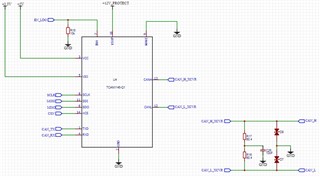Hello,
I am designing an electronic card based on an ESP32 and with a TCAN1146 as CAN transceiver to have the Partial Networking functionality.
I want to use Pin INH to activate the main power supply of my card from a CAN message to be configured in the TCAN1146.
The problem I'm having is that I can't send or receive CAN messages when the transceiver is in normal mode.
With a classic CAN transceiver I can send and receive CAN messages.
So I don't think I have any problem with the ESP32 firmware.
I have SPI communication working between the ESP32 and the TCAN1146. As well as the basic functions of writing and reading registers.
I tested the continuity on the CAN_RX / CAN_TX pins between the TCAN1146 and the ESP32 and the CAN_L / CAN_H continuity between the transceiver and the connector on my card.
There is no problem on that side either and I have 120 ohm between CAN_L and CAN_H.
At first, I do not activate the Selective Wake and I switch the tranceiver to normal mode by writing 0x07 in the MODE_CNTRL Register (Address = 10h).
By reading the register, I confirm that the transceiver is in normal mode, I recover the value 0x07 but the CAN communication does not work. CAN configuration is 500kbps in Standard Mode.
Am I forgetting a step in the configuration of the tranceiver to have CAN communication?
I put you below the values of the relevant registers that I have.
INT_1 Register (Address = 51h) = 0x40 or 0x44 (CANINT and sometimes CANSLNT raised)
INT_2 Register (Address = 52h) = 0x40 (PWRON raised)
Even if I clear the raised interrupts, the CAN communication still not work.
I've spent a lot of time trying to make this transceiver work.
The card must be produced in 3000 copies to start. If I can't unlock the use of this transceiver quickly, I will have to switch to a standard CAN transceiver.
I remain of course at your disposal and I thank you very much for the technical support that you can provide me.
Best,
Loïc FOLGOAS


